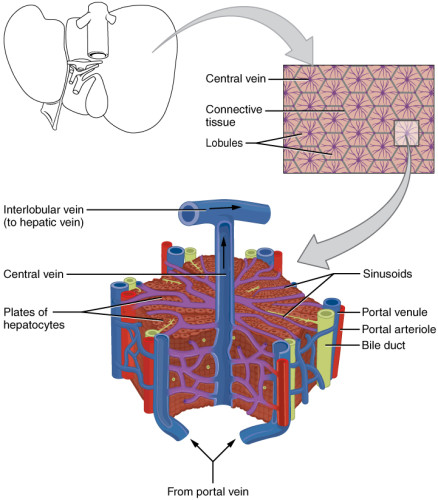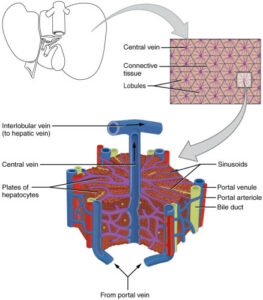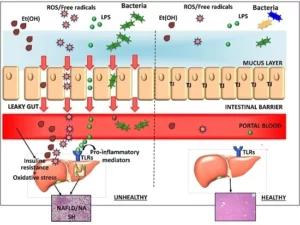Why a liver on a chip?
The liver is part of the digestive tract, and the main organ involved in the metabolism of xenobiotics, thus in toxicological studies (either fundamental or during the drug development path), it is mandatory to test the chemical on the liver. Currently in use models are badly predictive of what is then observed in humans. Liver toxicity is one of the major causes of arrest during clinical phases of the development of a new drug, with the so-called Drug-Induced Liver Injury (DILI).

How to culture vascularized & immunocompetent 3D models in a standard Multiwell
What has already been achieved in the organ on a chip liver field?
The first model that might be closed to a liver on a chip is an assembly of micro-pillars in microwells (532 wells plate) with a 60nL capacity (1). Hepatic cells are suspended in a Matrigel and then placed on the micro-pillar. This model is compatible with high-throughput screening methods (HTS).
Regarding HTS methods, it is now possible to use micropatterning techniques (soft lithography) with co-cultured cell types in a 384 wells plate (Bhatia et al). The main issue remains the use of PDMS which absorbs some drugs.
Jumping to liver on a chip, a team in Pittsburg University (Lansing & Vernetti) has developed a liver containing hepatocytes, endothelial cells, Kupfer cells, and stellate cells (a) (2). Cells are coming from a biopsy or of nonusable organ donation. This system is used for hepatotoxicity assessment (dead and bursting of cells) with the aim to better predict and prevent the occurrence of DILI. Emulate has developed a liver-on-chip containing several cell types. This chip is currently used by the FDA (b). The Healy lab has developed a liver on chip derived from iPS cells with 4 weeks viability (c).
BioMEMS has developed a microfluidic device aiming at mimicking hepatic sinusoids aiming at better prevent DILI. This device contains the same cell types as Lansing’s one (3).
A collaborative project involving Columbia University, MIT, Boston University, and the Wyss Institut combined iPS differentiated in a 3D scaffold mimicking the environment of a hepatic lobule. This device is then coupled to a similar device containing heart cells or blood microvessels. The platform might be used to model diseases and during drug screening steps.
A team hosted at Harvard University (Khademhosseini et al) has bio-printed a hepatic spheroid on a microfluidic device (4).
Columbia University and MIT are collaborating on a hepatic spheroid on a chip device as well.
Globally, 2 types of platforms are used: statics platform (without perfusion system) and platform with a perfusion system. The last is used by Griffith et al (MIT), Toh, and colleagues (they generate a concentration gradient of a given chemical). Hµrel company also developed a platform with a perfusion system on a mono-layer of hepatic cells to evaluate the elimination of a given pharmaceutical, then extended to be compatible with co-culture.
What’s next in the liver-on-a-chip field?
The main issue with the “liver” organ on a chip is the bile ducts that have not been recreated yet. Once done, connected liver-on-a-chip with gut on a chip will give a more global vision about the way a chemical is washed out the body.
To go further simple liver-on-a-chip, scientists are developing PBPK (physiology-based pharmacokinetic) approaches to model what could be the whole organism reaction.
References
- Trends Biotechnol. 2017 Feb;35(2):172-183. doi: 10.1016/j.tibtech.2016.08.001. Epub 2016 Sep 2. Engineered Liver Platforms for Different Phases of Drug Development. Ware BR, Khetani SR
- Exp Biol Med (Maywood). 2016 Jan; 241(1): 101–114. A human liver microphysiology platform for investigating physiology, drug safety, and disease models. Lawrence A Vernetti, Nina Senutovitch, Robert Boltz, Richard DeBiasio, Tong Ying Shun, Albert Gough, and D Lansing Taylor
- http://www.biomemsrc.org/research/cell-tissue-microengineering/liver-on-a-chip
- Biofabrication. 2016 Jan 12;8(1):014101. doi: 10.1088/1758-5090/8/1/014101. A liver-on-a-chip platform with bioprinted hepatic spheroids. Bhise NS1, Manoharan V, Massa S, Tamayol A, Ghaderi M, Miscuglio M, Lang Q, Shrike Zhang Y, Shin SR, Calzone G, Annabi N, Shupe TD, Bishop CE, Atala A, Dokmeci MR, Khademhosseini
And also :
Miniature liver on a chip could boost US food safety
Meet Chip: Liver (from NIH)
A perfusion incubator liver chip for 3D cell culture with application on chronic hepatotoxicity testing



